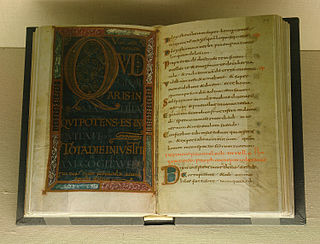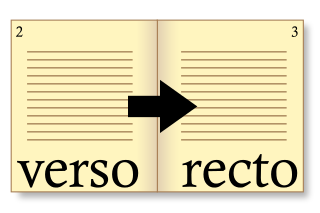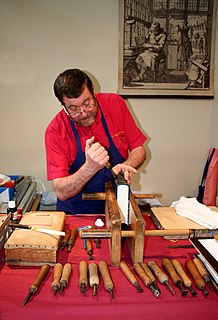Related Research Articles

Autumn, also known as fall in North American English, is one of the four temperate seasons. Autumn marks the transition from summer to winter, in September or March, when the duration of daylight becomes noticeably shorter and the temperature cools considerably. One of its main features in temperate climates is the shedding of leaves from deciduous trees.

A book is a medium for recording information in the form of writing or images, typically composed of many pages bound together and protected by a cover. The technical term for this physical arrangement is codex. In the history of hand-held physical supports for extended written compositions or records, the codex replaces its immediate predecessor, the scroll. A single sheet in a codex is a leaf, and each side of a leaf is a page.

A codex, is a book constructed of a number of sheets of paper, vellum, papyrus, or similar materials. The term is now usually only used of manuscript books, with hand-written contents, but describes the format that is now near-universal for printed books in the Western world. The book is usually bound by stacking the pages and fixing one edge to a spine, which may just be thicker paper, or with stiff boards, called a hardback, or in elaborate historical examples a treasure binding.

In botany, a bud is an undeveloped or embryonic shoot and normally occurs in the axil of a leaf or at the tip of a stem. Once formed, a bud may remain for some time in a dormant condition, or it may form a shoot immediately. Buds may be specialized to develop flowers or short shoots, or may have the potential for general shoot development. The term bud is also used in zoology, where it refers to an outgrowth from the body which can develop into a new individual.

A notebook is a book or binder of paper pages, often ruled, used for purposes such as recording notes or memoranda, writing, drawing or scrapbooking.

A psalter is a volume containing the Book of Psalms, often with other devotional material bound in as well, such as a liturgical calendar and litany of the Saints. Until the emergence of the book of hours in the Late Middle Ages, psalters were the books most widely owned by wealthy lay persons. They were commonly used for learning to read. Many Psalters were richly illuminated, and they include some of the most spectacular surviving examples of medieval book art.
Cancel or cancellation may refer to:
Octavo, a Latin word meaning "in eighth" or "for the eighth time", is a technical term describing the format of a book, which refers to the size of leaves produced from folding a full sheet of paper on which multiple pages of text were printed to form the individual sections of a book. An octavo is a book or pamphlet made up of one or more full sheets on which 16 pages of text were printed, which were then folded three times to produce eight leaves. Each leaf of an octavo book thus represents one eighth the size of the original sheet. Other common book formats are folios and quartos. Octavo is also used as a general description of size of books that are about 8 to 10 inches tall, and as such does not necessarily indicate the actual printing format of the books, which may even be unknown as is the case for many modern books. These terms are discussed in greater detail in book sizes.

Recto and verso are respectively, the text written or printed on the "right" or "front" side and on the "back" side of a leaf of paper in a bound item such as a codex, book, broadsheet, or pamphlet.
Anerratum or corrigendum is a correction of a published text. As a general rule, publishers issue an erratum for a production error and a corrigendum for an author's error. An erratum is most commonly issued shortly after its original text is published.

A page is one side of a leaf of paper, parchment or other material in a book, magazine, newspaper, or other collection of sheets, on which text or illustrations can be printed, written or drawn, to create documents. It can be used as a measure of communicating general quantity of information or more specific quantity

The size of a book is generally measured by the height against the width of a leaf, or sometimes the height and width of its cover. A series of terms is commonly used by libraries and publishers for the general sizes of modern books, ranging from folio, to quarto (smaller) and octavo. Historically, these terms referred to the format of the book, a technical term used by printers and bibliographers to indicate the size of a leaf in terms of the size of the original sheet. For example, a quarto historically was a book printed on a sheet of paper folded twice to produce four leaves, each leaf one fourth the size of the original sheet printed. Because the actual format of many modern books cannot be determined from examination of the books, bibliographers may not use these terms in scholarly descriptions.

Pasteles, also known as pastelles in the English-speaking Caribbean, are a traditional dish in several Latin American and Caribbean countries. In Puerto Rico, the Dominican Republic, Trinidad and Tobago, the Caribbean coast of Colombia, and Panama. It looks like a tamale. In Central American cuisine, it more closely resembles a British pasty or an Italian calzone. In other Spanish-speaking countries, pastel is a generic term for pastry. In Hawaii, they are called pateles in a phonetic rendering of the Puerto Rican pronunciation of pasteles, as discussed below.

The Grandes Heures de Rohan is an illuminated manuscript book of hours, painted by the anonymous artist known as the Rohan Master, probably between 1418 and 1425, in the Gothic style. It contains the usual offices, prayers and litanies in Latin, along with supplemental texts, decorated with 11 full page, 54 half page, and 227 small miniatures, decorated with tempera paints and gold leaf. The book margins are decorated with Old Testament miniatures with captions in Old French, in the style of a Bible moralisée. The full page illuminations are renowned for the highly emotional and dramatic portrayal of the agonies of Christ and the grief of the Virgin. According to Millard Meiss, "The Rohan Master cared less about what people do than what they feel. Whereas his great predecessors excelled in the description of the novel aspects of the natural world, he explored the realm of human feeling." Meiss concludes that the Rohan Master was the "greatest expressionist in 15th century France." Today, this manuscript is housed in the Bibliothèque Nationale, Paris, France.

Quarto is a book or pamphlet produced from full "blanksheets", each of which is printed with eight pages of text, four to a side, then folded twice to produce four leaves. The leaves are then trimmed along the folds to produce eight book pages. Each printed page presents as one-fourth size of the full blanksheet.

The term "folio", from the Latin folium (leaf), has three interconnected but distinct meanings in the world of books and printing. It is firstly a term for a common method of arranging sheets of paper into book form, folding the sheet only once, and a term for a book made in this way. Secondly, it is a general term for a sheet, leaf or page in (especially) manuscripts and old books, and thirdly, an approximate term for the size of a book, and for a book of this size.

Bookbinding is the process of physically assembling a book of codex format from an ordered stack of paper sheets that are folded together into sections or sometimes left as a stack of individual sheets. The stack is then bound together along one edge by either sewing with thread through the folds or by a layer of flexible adhesive. Alternative methods of binding that are cheaper but less permanent include loose-leaf rings, individual screw posts or binding posts, twin loop spine coils, plastic spiral coils, and plastic spine combs. For protection, the bound stack is either wrapped in a flexible cover or attached to stiff boards. Finally, an attractive cover is adhered to the boards, including identifying information and decoration. Book artists or specialists in book decoration can also greatly enhance a book's content by creating book-like objects with artistic merit of exceptional quality.

The Eadwine Psalter or Eadwin Psalter is a heavily illuminated 12th-century psalter named after the scribe Eadwine, a monk of Christ Church, Canterbury, who was perhaps the "project manager" for the large and exceptional book. The manuscript belongs to Trinity College, Cambridge and is kept in the Wren Library. It contains the Book of Psalms in three languages: three versions in Latin, with Old English & Anglo-Norman translations, and has been called the most ambitious manuscript produced in England in the twelfth century. As far as the images are concerned, most of the book is an adapted copy, using a more contemporary style, of the Carolingian Utrecht Psalter, which was at Canterbury for a period in the Middle Ages. There is also a very famous full-page miniature showing Eadwine at work, which is highly unusual and possibly a self-portrait.

The following outline is provided as an overview of and topical guide to books:

Fragmentology is the study of surviving fragments of manuscripts. A manuscript fragment may consist of whole or partial leaves, typically made of parchment, conjugate pairs or sometimes gatherings of a parchment book or codex, or parts of single-leaf documents such as notarial acts. They are commonly found in book bindings, especially printed books from the 15th to the 17th centuries, used in a variety of ways such as wrappers or covers for the book, as endpapers, or cut into pieces and used to reinforce the binding. In other non-Western manuscript cultures, fragments of paper manuscripts and other materials, takes place beside parchment, including board covers that many times reused written paper.
References
- ↑ Bibliographical Notes and Queries - Volumes 1-2 - Page 11 1935 - Normally, a cancel leaf is of course later than what I may call an integral leaf.